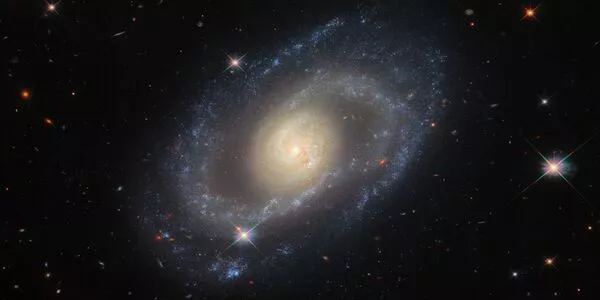According to a new study led by UCL researchers, a ring of planetary debris studded with moon-sized structures has been observed orbiting close to a white dwarf star, hinting at a nearby planet in the “habitable zone” where water and life could exist. White dwarfs are the glowing embers of stars that have depleted their hydrogen fuel. Almost all stars, including the Sun, will eventually collapse into white dwarfs, but little is known about their planetary systems.
An international team of researchers used data from ground- and space-based telescopes to measure light from WD1054-226, a white dwarf in the Milky Way, in the study published in Monthly Notices of the Royal Astronomical Society.
Surprisingly, they discovered pronounced dips in light corresponding to 65 evenly spaced clouds of planetary debris orbiting the star every 25 hours. The researchers concluded that the precise regularity of the transiting structures – dimming the star’s light every 23 minutes – suggests that they are kept in such a precise arrangement by a nearby planet.
According to lead author Professor Jay Farihi (UCL Physics & Astronomy), “this is the first time astronomers have detected any kind of planetary body in the habitable zone of a white dwarf.”
The possibility of a planet in the habitable zone is both exciting and unexpected; we were not expecting this. However, it is important to remember that more evidence is required to confirm the presence of a planet. We cannot observe the planet directly so confirmation may come by comparing computer models with further observations of the star and orbiting debris.
Professor Farihi
The moon-sized structures we’ve seen are irregular and dusty (e.g., comet-like), rather than solid, spherical bodies. Their absolute regularity, with one passing in front of the star every 23 minutes, is a mystery we cannot currently explain.
“One intriguing possibility is that these bodies are kept in such an evenly spaced orbital pattern due to the gravitational influence of a nearby planet. Without this influence, friction and collisions would cause the structures to disperse, losing the precise regularity that is observed. The gravitational pull of moons orbiting Neptune and Saturn aids in the formation of stable ring structures orbiting these planets.”
“The possibility of a planet in the habitable zone is both exciting and unexpected; we were not expecting this. However, it is important to remember that more evidence is required to confirm the presence of a planet. We cannot observe the planet directly so confirmation may come by comparing computer models with further observations of the star and orbiting debris.”
This orbit around the white dwarf is expected to have been cleared during the giant star phase of its life, so any planet that can potentially host water and thus life would be a recent development. The region would be habitable for at least two billion years, with at least one billion years to come. Over time, more than 95 percent of all stars will become white dwarfs. The largest stars that explode and become black holes or neutron stars are the exceptions.

“Because our Sun will become a white dwarf in a few billion years,” Professor Farihi added, “our study provides a glimpse into the future of our own solar system.”
When stars run out of hydrogen, they expand and cool, transforming into red giants. In four to five billion years, the Sun will enter this phase, swallowing Mercury, Venus, and possibly Earth. The hot core of the star remains after the outer material has been gently blown away and the hydrogen has been exhausted, slowly cooling over billions of years – this is the star’s white dwarf phase.
Planets orbiting white dwarfs are difficult to detect because the stars are fainter than main-sequence stars (like the Sun). So far, astronomers have only discovered circumstantial evidence of a gas giant (similar to Jupiter) orbiting a white dwarf.
Researchers used the ULTRACAM high-speed camera attached to the ESO 3.5m New Technology Telescope (NTT) at the La Silla Observatory in Chile to observe WD1054-226, a white dwarf 117 light years away, and recorded changes in its light over 18 nights. To better interpret the changes in light, the researchers also examined data from NASA’s Transiting Exoplanet Survey Satellite (TESS), which confirmed the planetary structures had a 25-hour orbit.
They discovered that the light from WD1054-226 was always partially obscured by enormous clouds of orbiting material passing in front of it, implying that the star is surrounded by a ring of planetary debris.
The habitable zone, also known as the Goldilocks zone, is the temperature range where liquid water could theoretically exist on the surface of a planet. In comparison to a star like the Sun, the habitable zone of a white dwarf will be smaller and closer to the star because white dwarfs emit less light and thus heat.
The structures observed in the study orbit in an area that would have been enveloped by the star while it was a red giant, so they are likely to have formed or arrived relatively recently, rather than having survived the star’s and its planetary system’s birth.





